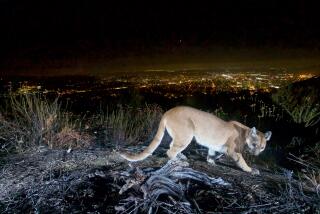Opinion: California bans bobcat trapping--good news for cats, bad for rodents
At a time when the killing of the beloved lion Cecil, in Zimbabwe, sparked global outrage and a debate over trophy hunting, there is good—and heartening!—news from the wilds of California: the state’s Fish and Game Commission has outlawed bobcat trapping. Commercial, recreational—all outlawed. The commission voted 3 to 2 at its Wednesday meeting in Fortuna to prohibit the trapping of bobcats.
The exotic felines with their bobbed tales and luxurious spotted coats were sought after by trappers selling their belly fur pelts in foreign markets. Highly adaptable and found throughout the state, bobcats are ecologically important for dispatching rabbits and rodents.
The state was headed toward some kind of new restrictions. The Bobcat Protection Act, AB 1213, written by Assemblyman Richard Bloom (D-Santa Monica) and signed into law in 2013, prohibited bobcat trapping outside Joshua Tree National Park—where bobcats are protected—and other state and national parks, and required that buffer zones be established. That’s a lot of zone-drawing.
The Department of Fish and Wildlife—which implements the policy set by the Commission on Fish and Game—proposed two options: setting up zones across the state for trapping or simply banning it statewide. The department recommended the zonal approach. And even though the bobcat population hasn’t been surveyed in more than three decades, department officials were confident the population was robust enough to sustain trapping at its current levels. (About 1,300 bobcats were taken by trappers in the 2013-14 season, and about 1,200 were taken the season before.)
I’m impressed that the commission voted to ban, entirely, the trapping of bobcats. Commissioners could have easily done the zonal approach and taken the department’s word about the sustainability of the population. Instead, they opted for a clear and more easily enforced standard. No trying to figure out whether trappers were in the right zone when they got their bobcats.
And, beyond that, the decision reflects—and respects--a growing sensibility in this state (and elsewhere) that wildlife should not be stalked, trapped, shot or beaten to death for sport or for traffic in frivolous goods.
Nicole Paquette, vice president of wildlife protection for the Humane Society of the U.S., summed up this view perfectly in her response to the commission’s action: “In the wake of the tragic death of Cecil the lion, the public has never been more aware that killing an animal for its pelt is no worse than for a head and hide to decorate a trophy room.”
Bobcat hunting, for some reason, will still be allowed. Most bobcats are trapped. Hunters killed about 300 cats in the 2013-14 season. If bobcat trapping had continued, as laid out in the 2013 law, the state trapping program would have had to become self-sufficient. Times reporter Louis Sahagun noted in his recent story about the bobcat proposals that trappers would go from paying $113.75 for a license—to paying a $1,325 trapping fee. That increase, alone, was expected to winnow out some trappers.
Follow the Opinion section on Twitter @latimesopinion
More to Read
A cure for the common opinion
Get thought-provoking perspectives with our weekly newsletter.
You may occasionally receive promotional content from the Los Angeles Times.











